As you might guess from a title like that, we’re not going to be seeing puppies and ducklings in this post. The tags would give more than a clue, but they’re perversely at the bottom, so you’d have to scroll past all the images to find out what you’re trying to avoid.
On a photo outing just over a week ago, the conditions had been kinda meh and we (meaning the Implacable Al Bugg and I) hadn’t seen a whole lot of wildlife, even in an area where we could usually spot something dependably. This was Duke Forest, where at least a few water snakes could be found, but it was surprisingly quiet this time around, so we spent a bit of time experimenting with moving-water shots – the level of New Hope Creek [a small aside: half a billion things are named “New Hope” in NC, and I’m pretty sure it’s state law that one road in every town is so-named] was notably higher due to recent rains. This is as pleasant as the images are going to get.
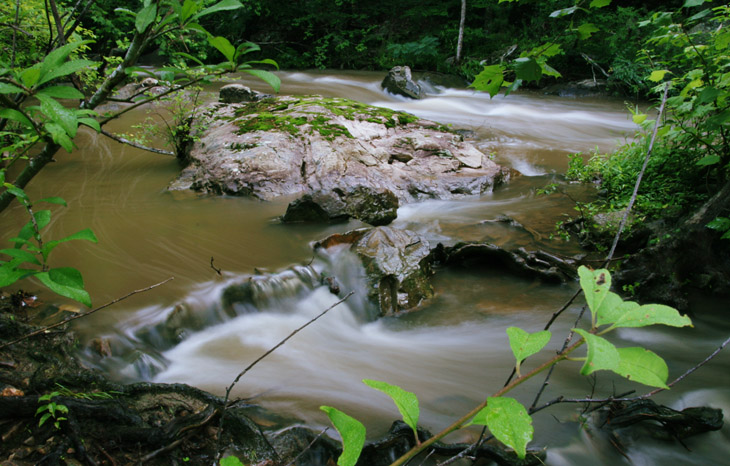
We did see one snake perched in the top of a small sapling that was flooded at the base, quite possibly driven there by even higher water levels earlier, but it was so difficult to see clearly that I’m not even sure of the species; I suspect a queen snake.
On the way back up out of the valley, however, I spied a recognizable spider crossing the path, quite pleased because I’d never seen an adult – it was a trapdoor spider, genus Ummidia. Several years back I’d photographed a cluster of newborns right in the yard, being surprised when they were identified on BugGuide.net because I didn’t think we had any such class of arachnid in the area, but then I’d never seen another example. This one, pretty large as spiders in the area go (about 40mm in leg spread,) was proving difficult to photograph on location, not able to be convinced to hold still and in poor light, so I coaxed it into a film can and brought it home for some detailed images. You know, nice and close.
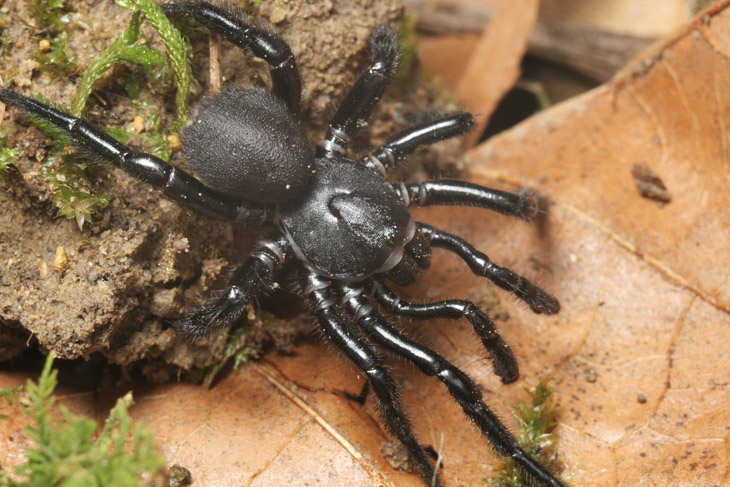
No, I said close.
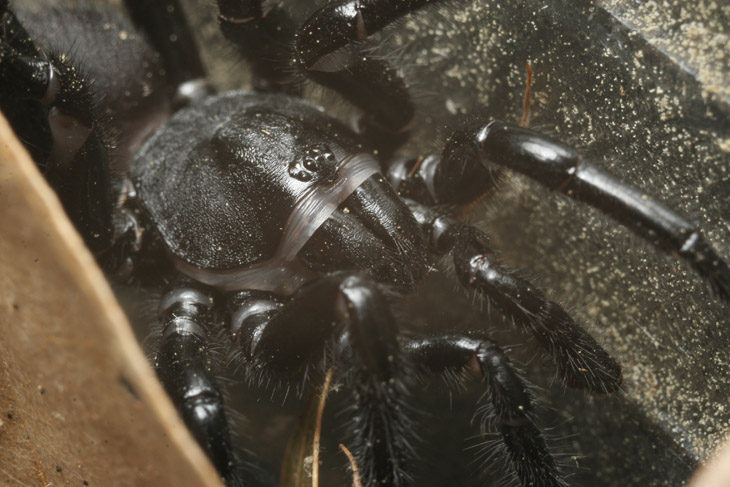
They’re called trapdoor spiders for a reason, and it’s for this reason that they’re not often seen: they usually stay secreted in a silk-lined vertical tunnel in the soil, capped with a hinged lid camouflaged to look like the forest floor, and leap out to snag prey that wanders too close. Naturally enough, I don’t yet have any images to illustrate this, since my subject here was found out on walkabout instead of chilling at home. One day, one day – it’s on my list of things to photograph. If I had to actually produce this list in written form it would take days or weeks, not (exactly) from the length of it, but simply from the idea that I vow to capture some image and this sits in the deep recesses of my mind, brought forth only when something happens to remind me again. Should some editor or science museum want to spend good money for detailed images, I could be persuaded to crawl around on the forest floors, combing the earth for something next to impossible to see, but this could understandably take days. In other words, I’ll stick to snagging what I happen to find rather than trying to eliminate items from my list, unless someone expresses a specific need.
Trapdoor spiders, or at least my particular example here, aren’t inclined to hold still and model, instead seeking cover or ambling around quickly, and convincing this one to pause out in the open took some effort. In doing so I got a nice threat display, and managed to snag the shot before it abandoned the display to wander off again.

That’s head-on, right at the chin as it were, and there’s little mistaking the menace – nor was it an interpretation, as the spider bit the probe I was using to help it pose, several times. While it was significantly smaller than the fishing spiders I’ve photographed, I’m fairly certain those fangs (chelicerae) were bigger; I have no doubts one would notice a bite. But now I also wish I’d gotten some better photos of those pedipalps, since they seem to have a decent grasping mechanism, almost like pincers.
I’m slightly out of chronological order here, because finding the spider came after our other encounter for the day, which was a lot closer than it should have been – I nearly stepped on this one…
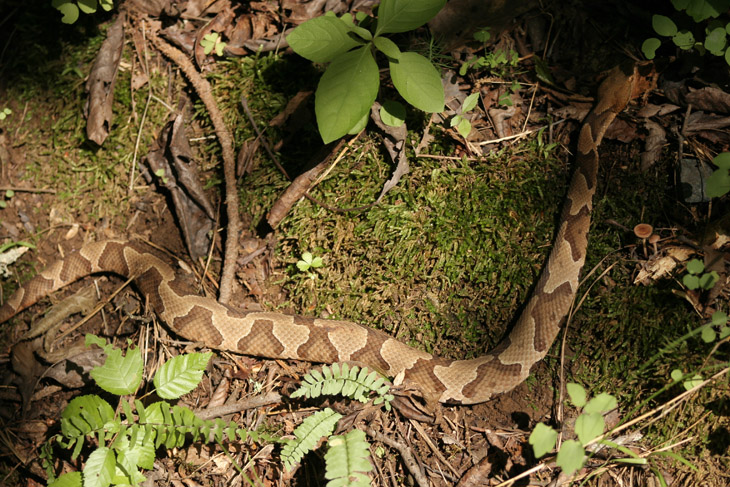
… which is embarrassing, really, because it was right on the edge of the main trail, a driveway actually, and it saw me before I saw it, beating a retreat as I stepped close. I know this is copperhead country, and keep an eye out in likely conditions, but I let my guard down on the gravel drive as we were leaving. Had it been as stubborn as my previous encounter, I might have been bitten.
This is a copperhead, but a southern subspecies, Agkistrodon contortrix contortrix – you can tell by the complete separation of the patterns along the spine, as if someone did a really shitty job of lining up the decals; only the southern variant displays this, while the northern can show mismatched patterns (like the forebody seen here) but not total breaks. Not large as far as snakes go, and perhaps small average for an adult copperhead, about 45cm overall. It slipped off the trail but paused not far away, and we were able to get a few detail shots as it watched us warily.

You have to appreciate it when your model, even while seeking cover, pauses with its head in the sunlight for a nice portrait. We were not anywhere near as close as this image makes it appear, however; this is a tight crop from the original, itself shot with the 80mm macro. It shows another identifying characteristic of venomous snakes in North America, but one that’s of little use. Venomous snakes have slit pupils, while all others have round ones. Getting close enough to make this out means you’re already far too close – I couldn’t even see it distinctly from my shooting distance.
[There’s yet another trait, even more worthless, but it’s one that I’ve used to show off on at least one occasion. Snakes have transverse belly scales stretching completely across the lower margins, giving a Venetian blind appearance. Once they reach the ‘vent,’ or genital/anal opening, all non-venomous snakes then split into two slightly staggered scales, while the venomous snakes maintain a single scale right to the tail tip. When a homeowner suspected there had been a snake hatching within their utility box, I found several molted skins from the newborns and could positively identify them as copperheads without ever having seen the snakes themselves.]
Here’s the full-frame version, almost the same as the one from which the image above was cropped, showing off how well camouflaged copperheads can be. I wouldn’t be half as embarrassed had I stepped too close to it in these conditions, but it was a lot more visible than this initially.
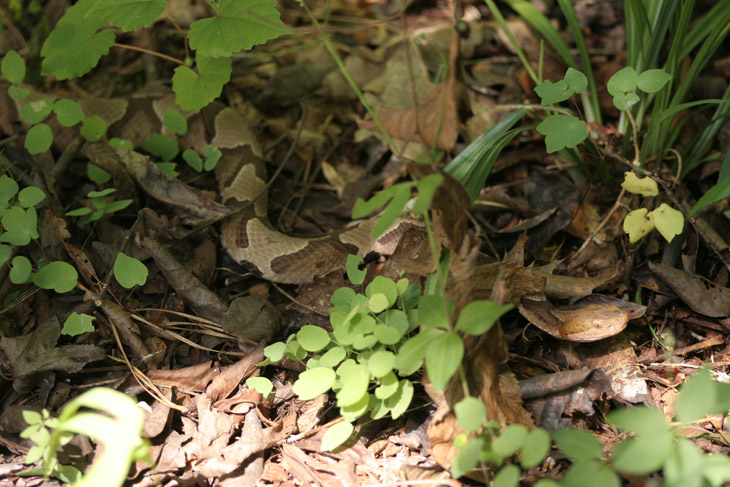
It largely stayed put as we cautiously maneuvered around for a variety of pictures, but when it started to shift into its ‘threatened’ display I called it quits and we left it alone. The common concept of this is that a snake “coils up,” and there’s even folklore that snakes cannot strike unless coiled; both of these are horseshit. A snake will “bunch up,” forming tighter S-curves while raising its head higher, allowing it a variety of movement options such as striking or just darting off rapidly – notice the difference in body curvature here versus the first image above. Once you see this, it’s time to back off. Coiling is a behavior usually intended to conserve body heat and provides a lot fewer options for the snake, but since people are more likely to encounter a snake when it’s basking and thus coiled up, this idea has remained around.
I would like to round out this phobia-inducing post with some images of clowns on the tops of tall structures, but I haven’t run across anything like that lately – be patient.



















































